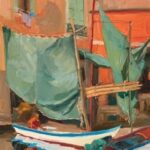
When I first considered making a contribution to the blog, it was with the thought of talking about the amazing and exceptional way Richeson manufactures our Oil Paint. I say that a bit tongue in cheek, because as a salesperson I know virtually every manufacturer will say the same. From my comfortable perch on this train I feel far more inclined to delay what I truly believe is a justifiable “sell job” for a future blog. Instead I would prefer to share with you a secret about the many many manufacturers and retailers that make or sell the many ranges of Mediums you use in the pursuit of your passion.

You see……many are artists in their own right who have ventured into the strange land of making or selling art materials out of a desire to stay close to the artist community as they earn a living and yet while under cover of darkness they pursue their art after working hours. I also know many folks involved in manufacturing who got their start as frustrated artists desperate to improve the quality of a medium but were frustrated with the materials available to them.

There is however a dark side to the secret I share with you. An ugliness has been creeping into the passionate Retailer and Manufacturer’s pursuit to serve the Artist Community. The never ending push to drive down the cost of artist materials over the recent years is at risk of seriously impacting quality. You may well ask……Is competitive price reduction such a bad thing? After all…..I confess…..I too must shop for the best value I can afford.


So where is all this rambling on a long train ride from London to Edinburgh heading? It leads me first to reflect on my own guilt at too often purchasing solely on price and neglecting quality, only to later grumble and moan because the silly thing has not functioned or lasted as I expected. I chide myself and renew a commitment to purchase the finest quality widget or thing I can possibly afford for the money available to me.

Enough rambling from my seat on a train in the British Countryside. Next time I will expound on our passion at Richeson for producing only the finest Oils available at a price that is affordable without the need to take out a second mortgage!!!!
Travel
The Traveling Artist

After my youngest went off to boarding school a little over a year ago, I decided to create a new job for myself. The very-tall-order job I created was to become a “Traveling Artist.” The job description: learn how to paint like a master from living masters and then to blog about the workshops and classes that I attend. My blog is called TheTravelingArtist.net.
Like many of you, I was very frustrated with the art education that I received in college. For a very long time, I thought I was the only person on the planet who wanted to know how the old masters created their works of art. It would be wonderful if there were a “master” ranking list of current artists who paint like the original old masters. But as I cannot find one, I created one for myself. I have never showed it to anyone, but every time I hear about an artist or I see someone’s work at The Art of the Portrait Conference that I love, I look them up and find out if they give classes or workshops. I assign a star rating from 1 to 5 (although I have yet to give an artist a 5) and then attend workshops or classes by artists whom I rank highly. The list is constantly changing and readjusting as I discover new artists.
It took me months to find a place where I could take classes from someone I respected. I joyfully found my first class with Alex Tyng at the Wayne Art Center in Wayne, PA. And so my self-directed art education began.

Since this first class, I have attended classes and workshops from Aaron Westerberg, Rob Liberace, Jeremy Lipking, Ellen Cooper, Casey Baugh, Garth Herrick, Sadie Valeri and David Kassan in many different cities and countries. I am in Utah right now attending a great one with Ryan Brown. There have been workshops that I have not enjoyed, but when that has happened, I have followed my parents’ rule: “If you have nothing nice to say, don’t say anything at all.” So, I just don’t blog about them.
As a result of my experiences taking workshops and blogging, I have developed a number of resources for potential workshop students, including upcoming workshops, price lists, tips for working with models, and much more. But before you dive headfirst into the wonderful world of workshops, here is a list of “unexpected things to expect” about workshops, plus my suggestions to artist teachers who want to provide the best possible experience for their attendees:
Unexpected things you should expect when attending oil painting workshops
Traveling to a new city (or country!) can be logistically difficult and will often be expensive. The upfront workshop fees do not always include all costs, such as model fees, travel expenses for day trips, extra supplies, etc. Transportation can definitely be a limiting factor as well… how do I get to said day trip? Be prepared to be flexible, or be proactive and call ahead of time for ALL the logistical/financial details.

Workshop instructors can help make these situations easier by handling the logistics of the workshop and presenting them upfront. Communicate every aspect of the workshop ahead of time so attendees know when and where they have to be and which supplies are required. Then, help coordinate how to get there. This is doubly true for workshops in other countries. Your attendees are there to learn art, not memorize the local public transportation system or pay for your personal vacation.
*Additionally, charging model fees is stingy and rude; just don’t do it.
If you are traveling to a workshop, odds are that you are going to have to spend the night somewhere. Workshops do sometimes provide accommodations, but they do not always accommodate you. For example, I was surprised at one workshop to find that in my room was… another person. I had not been told that I would be sharing a room, and I was not happy about it at first, but the problem ended up being a blessing because I met someone who became a terrific friend. Whether you are someone who needs their own space or is up for making new friends, be aware that you may have to speak up ahead of time to get what you want.
An interesting way to approach the lodging logistics is to tell people upfront if you expect them to share a room before they sign up; then provide the option for them to pay extra for a single room. This way, if attendees feel very strongly about having their own space, it is an option, but it would cost more than doubling up. As in my case, I would never in a million years have agreed to a roommate given the straight option. On the other hand, I would have missed out on meeting a great friend.
Workshops don’t usually provide all the supplies you will need, and may not let you know what you need ahead of time. This means you might have to consider schlepping your easel with you, especially if it is a Plein Air workshop. Set up an arrangement ahead of time if your workshop does not already supply easels to take one on loan from the workshop. Also, if you happen to have paper towel preferences (my personal favorite is Viva), check for grocery or art stores near the workshop in advance. I know that sounds trivial, but think about the space packing paper towels takes up! Take advantage of those cool local art stores (like at the Scottsdale Artist School). You might find something you didn’t know you were missing.
If you are putting on a workshop that requires specific supplies, you are doing yourself and your students a disservice if you do not a) let them know ahead of time, or b) offer for sale what they will need. This is a great way for workshops to make a little extra money. Easels and paper towels are two crucial things, but you will make everyone’s life easier if you have a little of everything beforehand in the package price or for sale at the workshop, as people really are bound to forget something.

Workshop attendees gossip. We all do it. Here are the top 3 things we talk about:
Whether or not a teacher artist behaves appropriately and professionally around models and groupies. Okay. Workshop instructors, I am speaking directly to you. Want to get people who attend your classes talking about the right things? Be professional around your attendees, the models, and your “groupies” (yes, you know who they are).
How much personal attention an instructor gives each attendee. Even if an attendee is shy, no one wants to feel neglected. Your attendees are not cattle; they each have special needs. Keep workshops small, or come up with a system that allows you to interact one-on-one with each attendee. This will most likely mean tightrope walking between encouraging your attendees to ask questions and controlling that one attendee who is totally hogging your attention.
Money. If attendees are being charged for something, such as a model fee, that was not included in the original price, you can be sure they will have something to say about it. I really cannot overstate how rude that gesture is. Every attendee should be told upfront what costs are involved; this is a necessity. These starving artists are already paying a lot to be at the workshop, so the least you can do is be forthright about what they are getting into.
Closing Thoughts
For more pointers and opinions, head over to my blog. But I will end on a positive note, leaving you with three really cool ideas that were highlights of workshops for me:
A wonderful idea from the Townsend Atelier was how to handle jockeying for a good easel position. There were a lot of attendees and all of the easels were already set up with a number attached to them. Each attendee drew a number from a bowl and, via lottery system rules, had to go with whatever easel they drew.
Another great idea, from Charlie Miano of The Southern Atelier, was when he had his Italian father come up to the workshop one day and bring us a delicious Italian wedding soup as a kind of send-off lunch. It felt so nice to be appreciated and was a great way for the attendees to unwind at the end of the workshop.
Finally, at the Jeremy Licking workshop, we were given the email addresses of the fellow attendees. This provided a great forum for gossiping communication.
I hope this help you as you embark on your own wonderful adventure of workshop touring. I love it! The teaching is so concentrated I feel I make much more progress at a workshop than I do in a lengthy class.
Have questions or suggestions of a great master artist? Submit your comment below.
Art in Cuba and the Traveling Painter

Artists there make more money than doctors, lawyers or university professors. Why? Because they are not, like the others, state employees, and are able to keep more of what they make. Again, why? Because Castro considers them cultural ambassadors and curators, and very important to keeping the Cubans….Cuban.
Would it be worth it to live in Cuba, with the restrictions that entails, to be at the top of the food chain for a change? Not for me. But I can tell you that in many ways the young, hip, vibrant artists that I recently met on my trip to Havana were no different from artists here in the U.S. They were enthusiastic about their current work at the Biennial, complained about the price of art supplies which had to be imported from Europe and knew how to party. The Art gene is a powerful one.
I’ve just started paintings from that wonderful trip. The Cubanos are a beautiful, friendly group. The city of Havana reminds me of a stunning woman “of a certain age” whose beauty is still there under the surface of time’s wear, and I don’t know what they do to the black beans and rice (known as “Moors and Christians”) but my mouth waters just thinking about them. The Buena Vista Social Club music is in the air and makes you want to get up and dance in between endless rounds of mojitos and pina coladas.

Traveling Tips for Oil Painters
I wasn’t able to paint on this trip, but I’m often asked about the nuts and bolts of managing it all. Travel with art supplies takes some careful preparation. Finding art stores can be challenging, if not impossible, in some countries. Besides that, we all have our favorite colors and canvas surfaces and painting in a foreign country can be intimidating enough without trying to make do with unfamiliar supplies.
Since 9/11 the rules regarding combustibles are strict. I often avoid the problem by taking watercolors, but even then those little tubes often look suspicious to a TSA agent. I’ve had no trouble (so far) packing oil paints in my luggage and I thought I’d share what I do, with the understanding that we can but try…
- Before you leave, try to determine how many canvases you’ll be able to complete each day: one in the morning, one in the afternoon, one for good luck? How much paint will you need? If you don’t know how much paint you use in a week or two, start keeping track of what you use before you leave. You’ll probably need a lot of white paint and small (37ml) tubes of colors you use regularly, but just half a tube of specialty colors, like reds for flowers. Paint tubes are heavy, so find out the weight limit for your airline and pack carefully to avoid extra baggage charges.
- I make sure that I include a very visible note (see below) to the TSA on the outside of a double zip lock bag of paints. The note assures the TSA people that the contents are not combustible. I learned on the Gamsol site and others NEVER to refer to the contents as “paint”! The double bag is because the paints might pop open due to baggage hold pressure and you probably don’t want to wear dioxizine purple all over your clothes…for a week.
ATTN: TSA
THESE ARTIST COLORS ARE MADE FROM VEGETABLE OIL AND
CONTAIN NO SOLVENT.
ARTIST GRADE COLORS ARE VEGETABLE BASED WITH A FLASH POINT ABOVE 550.
THEY ARE NOT HAZARDOUS. - The next question is how to transport those precious wet canvases home. Once you know how many canvases you think you’ll need, there are several ways to carry and pack them efficiently. On my first trip to France I precut my 8 x 10” canvas with a 1/2 inch border around them. I carried three or four 1/8 inch gator boards that were another half inch larger than the canvas. (Wildlife painter Carl Rungius just thumbtacked the corners, so you can try that.) At the end of a painting session I pulled the wet canvas off the board, set it aside to dry, and taped a fresh one on for the next day. You can bring dozens of canvases this way with a minimum of weight and space. By the end of the trip–a week or two–the first canvases are pretty dry and can safely be stacked with sheets of waxed paper between them. The wet ones can be mounted on both sides of the boards and taped together with push pin “spacers”, then wrapped tightly in plastic for the trip home. You can also use a light weight card board wet box to transport them home. On my last trip to Italy, I brought Raymar’s Featherweight boards and loved them. Whatever method you decide to use, it helps to bring just one size board so they’ll stack and pack easily. You can always adjust the size with tape if you decide you need a different shape for a particular subject.
- Be sure to carry on the things you can’t live without. I carry a 2 to 3 oz. plastic bottle of Liquin in my carry on “liquids” bag and add a little of it each day to my white paint. That ensures that most of the colors will have some drying agent in them to help speed up the process. I carry on my brushes. We all have our favorites and are unlikely to find them in little out of the way towns). I also include a few canvases, boards and masking tape. These are the things that are hard to replace if my bag gets lost for a few days.
- Needless to say, you cannot pack or carry on Gamsol or turps–the first adventure in each town is finding some at a hardware store or art store if they have one! It helps if you can look up the words for “turpentine”, “mineral spirits”, “solvent” and “odorless” and write them down before you leave the country.
- I also make sure that my brush washer container is as odor free as I can make it–I wash it out in soapy water and double zip lock bag it to avoid having any problem there. I pack my palette knife in my luggage, too, and pray for it’s safe arrival.
- Finally, my “insurance kit”: I always carry on a very compact kit of watercolor paper, paints squeezed out in palette cups and left out to dry before I pack them, brushes and old film containers for water–if the oils don’t make it for a while, I still can hit the ground running and start painting when I arrive in town.


There are no guarantees and the rules change, so be sure to check airline websites before you leave, but these ideas have worked for me and I’ve had so many wonderful experiences painting abroad! I hope you’ll share any travel tips you’ve discovered in your travels with us on this blog. Happy painting–wherever you may be!
“A journey is a person in itself; no two are alike. and all plans, safeguards, policies and coercion are fruitless, we find after years of struggle that we do not take a trip; a trip takes us.”
-John Steinbeck